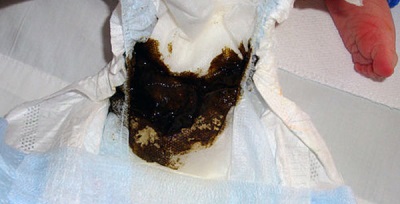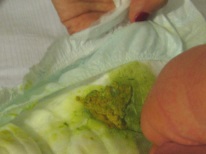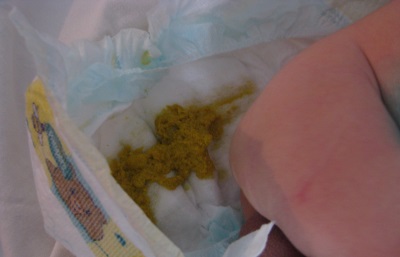Normal stool in an infant and its frequency
The contents of the nursing diaper are very diverse. Sometimes it is difficult for parents to understand whether the form of feces is normal for the baby. In order to worry less about the stool of a child of the first year of life, you should know how the baby feces look normal.
Have a newborn
In the first days of a newborn's life, his chair, called meconium, can frighten parents with black and green color and tarry consistency. The smell of such a chair is absent. However, this is an absolutely normal type of chair for a newly born baby. Such feces are substances swallowed by the baby in utero. The emergence of meconium means that the intestines of the baby began to work.

From the second day of life, the baby’s feces begin to change color (becomes grayish or gray-green) and the consistency (it becomes like an ointment or semi-liquid). Such a "transitional" type of feces shows that the baby receives colostrum in sufficient quantities and the milk is well absorbed in the body of the child.
Depending on the type of feeding
From the second week of life, the appearance and frequency of baby’s stools change. These changes are influenced by the type of feeding the baby.
Chest
In color, fecal masses may be yellow, mustard-colored or brownish. The smell of the stool of a baby who receives only breast milk is sour-milk, not harsh. The consistency of the stool is similar to liquid semolina, pea soup or curd. There are usually white patches in the stool, there may be a small amount of mucus, as well as a greenish tint, but if the baby’s well-being is not disturbed and the baby gains weight well, such signs of parents should not be worried.
In the first 1.5 months of life, a baby may be 4-12 times a day. Further, the frequency of emptying decreases. The norm for a child older than six weeks, receiving only mother's milk, is a chair from two to four times a day to one emptying in 2-5 days. The less a baby pokes, the larger the volume of his chair will be.
A breastfed baby's chair may change along with changes in the mother's diet. In addition, if parents peek into the stained diapers in the air, they will see that its contents are green. This is also the norm.
Artificial
The color of the baby’s stool that gets the milk formula is darker — yellow or brown. At the same time, the artificial baby should not have an orange or green, as well as a very dark (almost black) chair.
The smell at the stool of babies on artificial feeding is sharper. The consistency of fecal masses of infants who are fed with a mixture is thicker, but mushy. They may contain inclusions resembling cottage cheese, if the child was given too thick a mixture and it was not completely digested. An excessively thick stool is evidence of improper mixture preparation or overfeeding of the little ones.
The frequency of emptying the baby on artificial feeding in the first weeks of life does not differ from this indicator in a baby who receives breast milk (4-12 times per day). Then the infant, who is fed with mixtures, poops 3-4 times a day, and over time only 1-2 times a day.
Mixed
The chair of the baby, which is fed both by women's milk and milk mixture, has a rather thick consistency, but it can also be mushy.Its color is usually brown, may be light or dark. In the fecal masses there are small patches of greenery. The smell of feces quite sharp.
After the introduction of complementary foods
When the baby starts to try out complementary foods, his chair changes. It acquires a thicker consistency and a more unpleasant, harsh smell. The color of the stool of the baby, who is lured, is usually brown. In the fecal masses may appear blotches of different colors due to uncooked food, for example, beets or carrots. This is permissible, because boiled vegetables intestine baby digest is still difficult.
Constipation after the introduction of complementary foods it happens quite often, we advise you to read another article about it.











